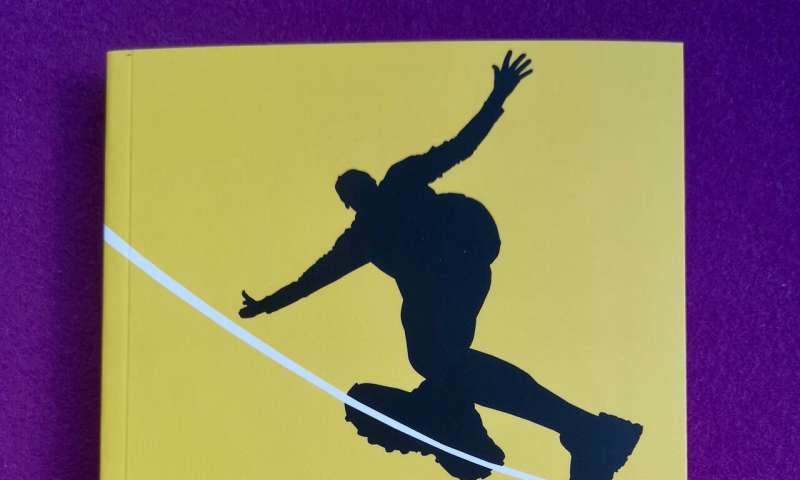The psychology of thrills and chills


Psychologist Kenneth Carter is not a fan of Halloween haunted houses. But he has written a book about people who thrive on activities like entering dark passageways, sensing that something unknown and terrifying awaits around the next corner.
“I don’t enjoy having things come out of nowhere,” says Carter, whose long-anticipated book “Buzz! Inside the Minds of Thrill-Seekers, Daredevils and Adrenaline Junkies” comes out Oct. 31. “Buzz!” both educates and entertains with insights from real-life adventurers, such as a scaler of skyscrapers, known as “Spider Man,” who enjoys hanging from great heights suspended by only his fingers.
Cambridge University Press is publishing the book, the culmination of years of research into high sensation-seeking people by Carter, a professor at Oxford College of Emory University and a self-described low sensation-seeking personality type.
“I love Halloween because it brings both extremes together, there’s something for everyone,” Carter says. “For me, it’s candy corn. That’s my second favorite candy, after Smarties. I enjoy the sweet, silly side of Halloween—not the dark, scary side. I don’t want to get lost in a corn maze or watch ‘The Children of the Corn.'”
Carter prefers art museums to haunted houses. He would rather read in a library than parachute from a plane. But he appreciates the psychology of more adventurous people and their value to society.
“It’s such a fun topic, and fascinating to me,” he says. “Everybody knows someone who is a high sensation-seeker, even if they’re not one themselves. To me, it’s thrilling to listen to their stories and get an idea of what’s going on inside their heads. Their motives are not what most people may assume.”
“Buzz!” falls into the genre of a “crossover book,” he explains. It can serve as a textbook, but also makes a great read for people who have never taken a psychology course. “One of the goals of psychology is to help people understand themselves and their loved ones better,” Carter says. “I hope that readers who are thrill-seekers, or those that have a friend or a relative who is one, will gain insights from the book.”
Carter, himself a graduate of Oxford College and Emory, is the Charles Howard Candler Professor of Psychology at Oxford. He designed and teaches a course on the psychology of the thrill-seeking personality offered by Emory and Coursera as a massive online open course. He also served as a consultant for the Canadian museum Science North as it developed an exhibit on sensation-seeking that is currently touring North America.
Carter’s low-sensation seeking personality was evident early, as he was growing up in Columbia, South Carolina. “I wasn’t one of those kids that tried daring things like jumping from high places,” he says. The biggest childhood adventure that Carter recalls was running away at age six. “After about an hour, I went back home,” he says. “I realized that I hadn’t really thought it through.”
This “born-to-be-mild” trait also influenced his boyhood preference for super heroes and Halloween costumes. “Batman was too dark and scary for me, too much in the shadows,” Carter says. “I loved the Green Lantern because he could summon up powers using his mind. That seemed like a wonderful, magical thing.”
Not surprisingly, Carter decided to focus his studies on the mind. After graduating from Oxford and Emory he went on to get his Ph.D. in psychology from the University of Michigan. It was as a graduate student that Carter experienced one of the scariest incidents of his life—entirely by accident.
His flight to Istanbul, Turkey, for a conference was delayed. When he arrived in the city, his conference host was not there waiting for him as planned so Carter checked into “a random hotel.” In a time before cell phones and the Internet were common, Carter felt adrift.
“I remember thinking, ‘No one knows where I am right now,'” Carter says. “Then I looked out my hotel room window and saw a bear. Actually, I saw a man walking a bear on a chain. It was sort of otherworldly.”

Such an unexpected sight would thrill many a traveler, but Carter is not among them. Low sensation-seeking personalities are used to making plans and sticking to them, he explains. Not being in control of a situation is more anxiety inducing than exciting.
“I’m the least chaotic person you’ll ever meet,” he says. “My friends can order for me in restaurants because they know what I’m going to get. And I enjoy my non-chaotic life.”
After receiving his Ph.D., Carter served as a research scientist in the Centers for Disease Control and Prevention’s Epidemic Intelligence Service, where he focused on smoking as a risk marker for suicidal behaviors in adolescents. He also earned a masters degree in psychopharmacology from Fairleigh Dickinson University and gained board certification as a clinical psychologist before joining the Oxford faculty in 1994.
Carter began to wonder why he craves calmness while some individuals seem drawn to chaos. He came across the research of Martin Zuckerman of the University of Montreal, who discovered that a subset of people thrives in environments that are overwhelming and frightening to others. Zuckerman was one of the first people to identify thrill-seeking as an important personality trait. He created a sensation-seeking scale to determine where individuals fall on a continuum of those who thrive on intense experiences and those who prefer to avoid them.
A defining characteristic of a high scorer on the sensation-seeking scale is someone who craves intense experiences despite physical or social risk. It’s a myth, however, to assume that they don’t value their lives, Carter says. “They don’t have a death wish,” he stresses, “but seemingly a need for an adrenaline rush, no matter what.”
Carter’s fascination with the topic drove him to seek out the personal stories of high sensation-seekers, even when that meant he had to deal with his own fears, such as heights. He met up with an adventurer named Nick on a bridge in Twin Falls, Idaho, as Nick strapped on a parachute and leapt over the edge for a sport called BASE jumping. “My heart jumped in my chest. My breathing was shallow,” Carter writes. “I was clearly rattled—and I was just watching.”
“Buzz!” also treats readers to an interview with an ice climber named Will Gadd who became the first to scale the frozen face of Niagara Falls. And then there’s Matt Davis, a self-described everyday guy who also happens to be “a mudder,” someone who enjoys obstacle race courses that involve belly-crawling under barbed wire and dashing through tents filled with tear gas. And Jeb Corliss, famous for donning a wingsuit—which transforms him into what Carter describes as “a giant flying squirrel”—and jumping off the Eiffel Tower in Paris.
They explain that these activities allow them to enter a flow state—an energized focus on the joy of the moment. High sensation-seekers need more stimulation than the average person to enter this state and studies suggest genetics may play a role. As Nick the BASE jumper told Carter: “From the time I was five years old, I just always wanted to fly. I can’t really explain it, it’s just part of my DNA. It’s just something I need to do.”
High sensation-seekers are not always extreme athletes. The personality trait can influence people’s lifestyles in all sorts of ways, Carter explains, from the way they think to the way they eat, socialize and travel.
He writes about “fearless foodies,” people who “seek sensations in bowls of chicken hearts, goat brains and pig blood stew, not because these foods are part of their cultural norms, but because they’re there.” And a blogger who calls herself the White Rabbit who set off to “follow the sun” on a 300-day journey during which she carried no money, but tons of chutzpah to convince strangers to let her crash on their couches.
One key takeaway from the book is that high sensation-seeking is a personality trait that can be positive or negative. Carter concludes that the good aspects more often outweigh the bad. For example, those with the ability to perform well in chaotic situations may excel as emergency medical technicians or even astronauts.
High sensation-seekers also serve as inspiration for the less adventurous, Carter adds. They are vivid reminders of the joy of “going with the flow,” the need to feel awe and the fun of occasionally trying new things.
That doesn’t necessarily mean watching the latest horror movie. Or putting on a wingsuit and jumping off a cliff.
Source: Read Full Article




